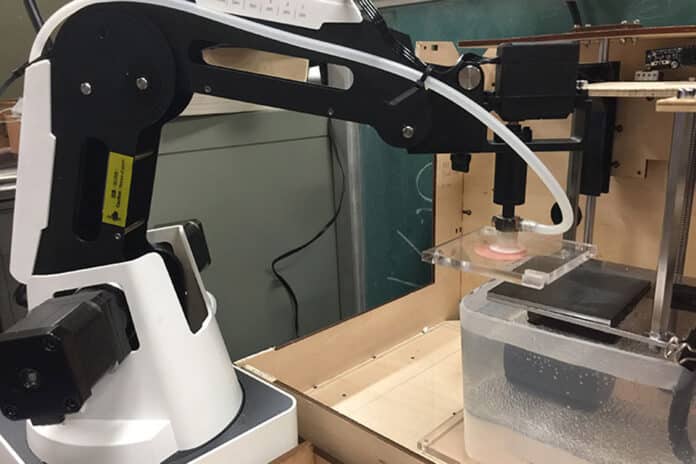3D printing or additive manufacturing is a process of making three-dimensional solid objects from a digital file. It enables users to produce complex (functional) shapes using less material than traditional manufacturing methods.
At a rapidly growing rate, the medical industry continues to recognize the added value of additive manufacturing (AM or 3D Printing) for a vast range of medical applications. AM is now used in the development of new surgical cutting and drill guides, orthopedic implants, and prosthetics, as well as the creation of patient-specific replicas of bones, organs, and blood vessels.
Unsurprisingly, the intricate, mushy tissues that make up most human organs are quite difficult to 3D print. But now it will be viable to 3D print biomaterials like organs and food using a device created by engineers at UC Berkeley. The device could become an extension of 3D printing that allows living tissue, bone, blood vessels, and even whole organs to be printed on demand.
Living cells require very specific temperatures and chemical conditions to survive and will often deteriorate during a lengthy printing session. The new device uses identical printers to create multiple layers simultaneously and then stack them one on top of the other to form the 3D structure. This arrangement speeds up the printing process and makes it more likely that the cells will stay alive.
To minimize cell death during the 3D printing of an organ, the Berkeley researchers developed a technique that employs parallelization, in which multiple printers produce 2D layers of tissues simultaneously. These 2D layers are then stacked layer-by-layer to form 3D structures.
To overcome the storage problem of these manufactured organs, the team relied on seven decades of knowledge and techniques for preserving single cells. Their technique freezes each 2D layer immediately after it is merged into the 3D structure, and this process of freezing a single layer of cells provides optimal conditions for surviving the process of freezing, storage, and transportation.
Boris Rubinsky, professor of mechanical engineering and co-author of the paper said, “Right now, bioprinting is primarily used to create a small volume of tissue. The problem with 3D bioprinting is that it is a very slow process, so you can’t print anything big because the biological materials will deteriorate by the time you finish. One of our innovations is that we freeze the material as it is being printed so that the biological material is preserved, and we can control the freezing rate.”
“By printing tissues in 2D first and then assembling them into a 3D object at a different station, we sped up production by essentially eliminating printing time. After the assembly line of bioprinters creates parallel multiple 2-D layers of tissue, a robotic arm picks up the layer and carries it to another station. There, the tissues are stacked together to create a 3D object and fused via freezing.”
Joseph Sahyoun (Meng ’18, ME) and co-author of the paper, said, “As each layer is stacked to form a 3D structure, one of the innovations we implemented was to dip the 3D structure into a cryogenic bath to freeze it rather than having the bath fill up to meet each layer. This method allowed us to control the freezing rate more accurately.”
Rubinsky said, “Dysphagia is very common among the geriatric population. Because these patients have difficulty swallowing, they are being fed food that is basically mush, so they don’t have an appetite, and the problem exacerbates. But if you can create food with texture, this may be more appetizing. Then as they chew, the food will melt in their mouth so they can swallow and get the nutrients. Our technology allows you to do that with any kind of food.”
”The technology also allows for the development of industrial-scale manufacturing of frozen food, where the structure of ice crystals in the food is meticulously controlled at the single cell layer throughout the product. This is important because the size of the ice crystals and the homogeneity of the ice crystals are a central element in the quality of the frozen food.”
Gideon Ukpai, a graduate student in Rubinsky’s lab and lead author of the paper, said, “There is a big difference between materials used in conventional lamination – like paper, plastics, ceramics, and metals – that are rigid, even in thin layers, and biological matter consisting mostly of liquid that is much less so.”
The 2D layers were printed on hydrophilic and hydrophobic rigid surfaces that allow the 2D layers to be transported across distances, regardless of the direction of gravity, for placement onto a 3D object.
For future research, Ukpai and a new cohort of master of engineering students from the Fung Institute will work to optimize this process better, characterize the products and determine the appropriate scenarios that present the most advantages.
A paper describing this work was recently published in the Journal of Medical Devices.
